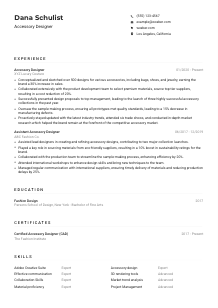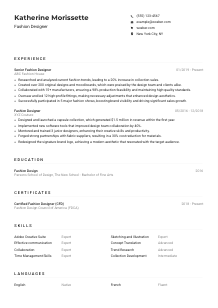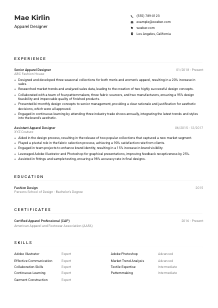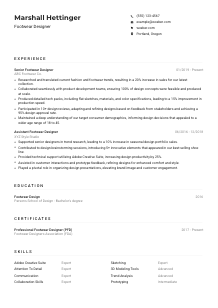Textile Designer Resume Example
Weaving wonders, but your resume feels frayed? Spin through this Textile Designer resume example, crafted with Wozber free resume builder. Learn how to blend your pattern prowess with job requirements, so your career story has the right touch and thread to impress!
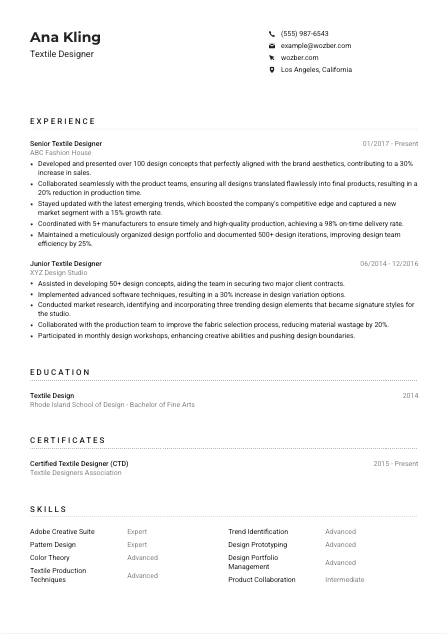
How to write a Textile Designer Resume?
Hello, creative visionary! In the dynamic world of textile design, your resume is more than a document. It's a canvas that showcases your talent, skill, and passion. With the help of Wozber, a free resume builder, this guide is your palette to paint a compelling picture that resonates with your dream job's requirements. Ready to dip your brush? Together, we'll create a resume that beautifully weaves your professional story, tailored precisely for the textile designer role you covet.
Personal Details
The 'Personal Details' section might initially seem as simple as choosing fabric for your next project, but it's the thread that begins your professional tapestry. Let's ensure it's perfectly dyed to match the job specifications for a Textile Designer.
1. Brand Yourself with Your Name
Just as a signature design sets you apart in the fashion world, your name should be a memorable emblem on your resume. Use a clear font that's easy on the eyes, making your name the headline of your masterpiece.
2. Align with Your Desired Role
Below your name, weave in the title 'Textile Designer,' just as you would carefully select a complementary color for a pattern. This immediately flags to the recruiter that your resume is tailor-made for the position.
3. Include Essential Contact Threads
- Phone Number: Like a carefully knotted thread, make sure your contact number is secure and correct.
- Professional Email Address: Your email should be a blend of professionalism and simplicity, akin to choosing the right fabric for a project. A format like firstname.lastname@email.com works best.
4. State Your Location with Precision
The job description calls for someone already in Los Angeles, California. Reflect this in your resume, seamlessly integrating this detail as if choosing the perfect backdrop for your design.
5. Weave in Your Professional Online Presence
Consider including your LinkedIn profile or portfolio website, ensuring they are both polished and mirror the creativity and professionalism of your resume. This is like adding an embellishment that brings the whole design together.
Takeaway
Craft your 'Personal Details' with the same care and precision you apply to a textile design. It's the beginning of your narrative, setting the stage for what's to come. With the right details, you introduce yourself not just as a candidate, but as a designer with a story to tell. Let's ensure it's professionally woven and perfectly aligned with the Textile Designer role you're pursuing.





Experience
The 'Experience' section is where the texture of your career comes to life. This is your chance to showcase the patterns of success you've created and the unique designs you've brought to life. Let's tailor this section precisely, ensuring each stitch aligns with the Textile Designer role's requirements.
- Developed and presented over 100 design concepts that perfectly aligned with the brand aesthetics, contributing to a 30% increase in sales.
- Collaborated seamlessly with the product teams, ensuring all designs translated flawlessly into final products, resulting in a 20% reduction in production time.
- Stayed updated with the latest emerging trends, which boosted the company's competitive edge and captured a new market segment with a 15% growth rate.
- Coordinated with 5+ manufacturers to ensure timely and high‑quality production, achieving a 98% on‑time delivery rate.
- Maintained a meticulously organized design portfolio and documented 500+ design iterations, improving design team efficiency by 25%.
- Assisted in developing 50+ design concepts, aiding the team in securing two major client contracts.
- Implemented advanced software techniques, resulting in a 30% increase in design variation options.
- Conducted market research, identifying and incorporating three trending design elements that became signature styles for the studio.
- Collaborated with the production team to improve the fabric selection process, reducing material wastage by 20%.
- Participated in monthly design workshops, enhancing creative abilities and pushing design boundaries.
1. Analyze the Fabric of the Job
Start by dissecting the job description. Highlight the experience it explicitly asks for—like proficiency in Adobe Creative Suite and a strong understanding of production processes. Your experience section should reflect these requirements as if selecting materials for a new collection.
2. Structure Your Design Portfolio
List your roles chronologically, starting with the most recent. For each position, include your title, the name of the company, and the dates you were there, as if you were outlining the pattern for a new garment.
3. Illustrate Your Achievements in Vivid Color
For each role, detail your achievements that match the job listing. If you improved sales by developing aligned design concepts or streamlined production processes, highlight these accomplishments as bold strokes in your design.
4. Quantify Your Design Successes
Whenever possible, add numbers to give dimension to your achievements. Did you increase sales by 30% or reduce production time by 20%? These are the vibrant colors that bring your experience to life.
5. Tailor to the Textile Design Role
Ensure every experience woven into this section is directly relevant to the role of a Textile Designer. Unrelated experiences are like mismatched patterns in a fabric—they detract from the overall design.
Takeaway
Imagine your experience section as the most elaborate and intricate part of your resume's tapestry. It shows where you've been, what you've created, and the impact you've had. This section should convince any hiring manager that you are not only a perfect fit for the role but that your designs will enrich their brand's collection. Think like a curator—choose only the most compelling pieces of your career to display.
Education
The 'Education' section of your resume might seem like choosing the base fabric for your designs—it provides the foundation upon which everything else is built. Let's ensure this section supports the structure of your career ambitions in textile design.
1. Select the Right Texture
Identify the specific education requirement from the job posting. In this case, it's a Bachelor's degree in Textile Design, Fashion Design, or a related field. Ensure your education section mirrors this foundation, as if selecting the base material for a new line.
2. Lay Out the Pattern
Present your educational background simply yet effectively. Structure it by listing your degree, the field of study, the school, and your graduation date, aligning it like the warp and weft in a loom.
3. Dye Your Degree with Specificity
If the job specifics align with your degree, ensure this is highlighted—like choosing the right shade from a color palette that perfectly matches your design concept.
4. Embellish with Relevant Courses or Achievements
For roles requiring a deep dive into specific areas, don't hesitate to list key courses or academic achievements that parallel the job's requirements. This could be seen as adding embroidery or embellishments to your base fabric.
5. Fold in Any Additional Educational Elements
If you have participated in relevant extracurricular activities, clubs, or projects, include these details. They add depth and texture to your academic background, similar to how different layers and textures add complexity to a garment.
Takeaway
Think of your education section as the base fabric of your resume. It's critical to ensure that it's strong, relevant, and clearly woven with the threads of your career goals in mind. As with selecting materials for a design project, choose the details of your educational background that best align with the Textile Designer role you aspire to fill. This foundation supports the magnificent design that is your career.
Certificates
Certificates are like the decorative stitches or embellishments that can truly make a garment—or in this case, your resume—stand out. They are testament to your dedication to craft and continuous improvement. Let's thread them into your resume beautifully.
1. Evaluate the Design Requirements
First, carefully review the job description to determine if specific certifications are mentioned. While our example did not list explicit certification requirements, it's crucial to match your certificates with the job's fabric.
2. Select Certificates That Highlight Your Palette
Choose to list those certificates that directly enhance your qualifications for the Textile Designer role. Quality over quantity ensures the hiring manager recognizes the most important aspects of your craft immediately.
3. Stitch in the Dates Neatly
Including the date of certification can be as critical as the care labels on textiles. These details tell the hiring manager that your skills are current and up-to-date, reflecting the ever-evolving trends in textile design.
4. Keep Your Patterns Current
The fashion and design industries continually evolve, requiring you to stay abreast of new techniques, materials, and technologies. Regularly update your certifications, ensuring your professional toolkit is as fresh and innovative as your design concepts.
Takeaway
Imagine your certificates as the fine details that catch the eye on a beautiful piece of fabric. When woven into your resume correctly, they add depth and intrigue, showing your dedication to your craft and your ongoing commitment to learning. Choose and present them thoughtfully, keeping them relevant and up-to-date, to stitch a perfect picture of your qualifications.
Skills
Your skills section is where you can display the versatility of your professional toolkit. Like a well-organized palette, it should present a range of shades and textures that highlight your capability as a Textile Designer. Let's sort through your skills and arrange them in a way that emphasizes your expertise and readiness for the role.
1. Shade in the Job's Requirements
Begin by identifying the explicit and implicit skills mentioned in the job description, such as proficiency in Adobe Creative Suite and an understanding of textile production techniques. Each skill you list should be a vibrant stroke that adds to your career canvas.
2. Arrange Your Skills with Precision
Lay out your skills meticulously, focusing on those that directly align with the job. Like choosing colors for a design project, select skills that complement each other and the role you're targeting.
3. Edit Your Skills for Composition
Resist the urge to list every skill you possess. A cluttered palette can be overwhelming. Instead, focus on the most impactful skills that showcase your expertise for the Textile Designer position.
Takeaway
Just as you would select the perfect combination of colors and textures for a textile design, your skills section should be a curated showcase of your capabilities. With each skill thoughtfully chosen and presented, you're telling the hiring manager that you not only possess the necessary expertise but are capable of creating results that resonate. Let your skills palette dazzle, reflecting your readiness to contribute to and enhance their designs.
Languages
In the global marketplace of textile design, linguistic versatility can be an invaluable asset. Each language you speak is like a unique pattern in your portfolio, offering opportunities for richer, more diverse creations. Let's align your linguistic abilities neatly within your resume, showcasing your ability to communicate in a rich tapestry of tongues.
1. Gather Your Linguistic Fabrics
Start by identifying any language requirements or preferences outlined in the job description. For our Textile Designer role, a strong proficiency in English was a must. This becomes the base thread of your linguistic section.
2. Highlight Your Language Mastery
Place your primary language, and any others you are proficient in, at the top of this section. Your proficiency levels—whether native, fluent, intermediate, or basic—should be clearly defined, like the varied textures of fabric indicating their use.
3. Add Any Additional Linguistic Patterns
Even if not specific in the job description, other languages you speak can add depth to your resume, much like adding layers to a design to create richness and complexity.
4. Be Transparent with Your Language Proficiency
Clearly describe your level of proficiency for each language. This honesty ensures expectations are set correctly, much like being transparent about the care instructions for textiles to maintain their beauty.
5. Match the Fabric to the Design
Understand how your linguistic skills fit into the broader picture of the role. For positions that have a global reach or involve collaborating with international teams, your multilingual abilities become an even more attractive and versatile asset.
Takeaway
Languages are like different threads that, when woven together, create a fabric rich in culture and possibilities. As you list your linguistic capabilities, consider each one a testament to your ability to connect with a broader audience, to weave more intricate and diverse narratives within your designs. Each language you speak opens a door to new inspirations and collaborations. Embrace your linguistic diversity as a strength, a unique pattern in the tapestry of your professional credentials.
Summary
Your summary is the golden thread that brings together the entire tapestry of your resume. It's your chance to captivate and charm the hiring manager with a concise narrative of your professional journey as a Textile Designer. Let's distill your essence into a few powerful lines, creating a prelude that invites the reader to explore more.
1. Reflect on the Overall Pattern
Start by absorbing the core themes of the job listing. This role seeks someone with a strong handle on Adobe Creative Suite, a deep understanding of textile production, and a proven track record in design success. Let these elements guide the narrative of your summary.
2. Sketch Your Professional Portrait
Introduce yourself with a sweep of broad strokes, summarizing your professional standing. Highlight your years of experience, major achievements, and areas of expertise, all while keeping the texture of the Textile Designer role in mind.
3. Highlight the Colors of Your Career
Detail a few key accomplishments or skills that directly respond to the job's requirements. Show how your unique blend of creativity, technical skill, and production know-how makes you an ideal fit for the position.
4. Trim and Tuck for Elegance
Ensure your summary is both snappy and substantial. Aim for a tight, impactful narrative that outlines your professionalism and passion, much like trimming the edges of a pattern for a perfect alignment.
Takeaway
Craft your summary as if it were the label on your garment—informing, enticing, and indicative of the quality within. This section should spark the hiring manager's interest, making them eager to delve deeper into the story of your career. With the right touch, your summary becomes a compelling invitation to explore the intricate designs and patterns that make up your professional expertise. Let it capture the essence of your creativity and technical skill, setting the stage for a rewarding journey ahead in textile design.
Embedding Your Vision into Every Fiber
Congratulations, creative spirit! You've now completed a full walkthrough on how to craft a resume that not only meets the requirements for a Textile Designer position but does so with style and substance. Remember, your resume is the loom upon which your professional narrative is woven. Each section, from your personal details to your career summary, contributes to the overall pattern of your unique career in textile design. Use the insights shared here, along with the free resume builder and ATS-compliant resume features at Wozber, to tailor your resume precisely for your dream role.
Your journey is just beginning, and the fabric of your career is rich with potential. Weave your story with confidence, creativity, and the knowledge that you've crafted a resume that truly represents you at your best. Now, go forth and design your future with every thread of talent you possess.

- Bachelor's degree in Textile Design, Fashion Design, or a related field.
- Minimum of 3 years of experience in textile design or a related position.
- Proficiency in industry-standard design software, such as Adobe Creative Suite or similar tools.
- Strong understanding of textile production processes and techniques.
- Exceptional creative and artistic abilities, with a keen eye for color, pattern, and texture.
- Strong English language proficiency required.
- Must be located in Los Angeles, California.
- Develop and present design concepts that align with brand aesthetics and target markets.
- Collaborate closely with product teams, ensuring designs translate seamlessly into final products.
- Stay updated on emerging trends, techniques, and materials in the textile design industry.
- Coordinate with manufacturers and suppliers to ensure designs are feasible for production.
- Maintain an organized design portfolio and documentation of design iterations.












